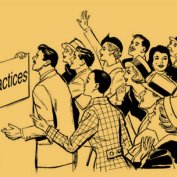

We are constantly bombarded with so many different social media sites that it can be hard to determine which will actually help you as a job seeker. Twitter and Facebook are a couple of the main ones that everyone has heard of, but what others out there should you be on to connect with potential employers? There are a few that are directed specifically at employers, potential employees, and networking in your field. The main social media site leading the pack in this area is LinkedIn.
What Is LinkedIn?
Think of LinkedIn as a huge networking event where there are millions of people instead of just hundreds. In this huge event, you will find people from every working field you can think of and more. No matter what type of field you are in, you will easily find millions of others that are either in the same field or interested in it. You can then connect with them through the site and grow your network of contacts. From there, you can easily use LinkedIn to search for potential employers, have them find you, and continue to build up your expert status.
How Do I Get On LinkedIn?
Setting up a profile on LinkedIn is pretty simple. Start by going to the LinkedIn website and registering for a free account. Once you register, you will enter in your email address and you can automatically import your contacts to quickly connect with people you already know. After you go through the starting steps, you will want to set your profile up so that those you connect with can easily see what you do. LinkedIn will walk you through the beginning steps to ensure that you get everything set up quickly and easily.
Showcasing Your Skills
Now that you have your profile set up and rocking, it’s time to add in the bells and whistles. Keep everything straight and to the point, making sure that you showcase your skills and experience. You can upload your resume, ask people you have already connected with for recommendations, add in your website and other social media sites that you are a member of, and join in conversations in your field. LinkedIn is set up to help you showcase your expertise in your field, and it will help others in the same field find you quickly.
For example, if you are an IT professional, you will want to list this along with experience, positions held, education, any certificates you’ve earned, and any other information that can help potential employers see how much of an asset you can be to them. If you hold specific certificate or training, such as a C++ certificate, Cisco CCNA training, or being a Microsoft Exchange Administrator, make sure that you list these as well as where you earned your certificates and training. Potential employers want to know about this training, as they may be looking for something specific from their candidates.
Expanding Your Connections
Once you have your profile set up all the way, it’s then time to start connecting and getting yourself out there. One of the quickest ways to do this is to search some of the available groups that pertain to your field. From the top navigation field, mouse over the “Groups” category. You will see a drop-down menu appear that will give you the option “Groups You May Like.” Select this option. LinkedIn will then pull up groups that match with the areas on your profile. Using the example above, if you have a profile full of IT information, the groups that pull up will be those that revolve around IT, technology, and other areas that fit your specific skill set. You can then join the groups that you like and start posting comments in them.
Groups are an excellent way to get yourself out there quickly on LinkedIn, as the majority of groups will have at least 50 members in them. All of the members in any group will be there to talk about that specific topic, such as breaking IT technology, and you will quickly find those that have the same passions that you do.
Rolling Into The Job Search
Now that you’ve gotten your profile set up, your bells and whistles added, and you’ve started posting in groups around your field, it is time to enter the LinkedIn job search. Up at the top in the category navigation bar, you will see a tab labeled “Jobs”. The dropdown menu here will offer you job searches if you are looking, and for those trying to find employees, they can search potential candidates (hence having your profile set up is a must before you hit this search). Of course, if you pay for a membership to LinkedIn, you’ll gain access to their premium area which offers you a bit more in the way of job searches, but you don’t have to have it to find good leads.
Remember that potential employers can see what’s on your profile when you apply for any position on LinkedIn, so ensure that you are keeping any new skills or training updated quickly on your profile. By keeping in touch with people on LinkedIn and adding new connections in your field, locating employers and applying for jobs will become easier and easier until they start finding you. Just treat your LinkedIn account as a constant job interview and you’ll start to see your expert status going straight up.












